San Sebastián Update
 Wednesday, September 18, 2019 at 05:33PM
Wednesday, September 18, 2019 at 05:33PM  After an hour's winding drive from Bilbao airport, the taxi arrives in Sebastián and drops us at Legazpi Doce Suites, a small all-suite hotel just outside the old quarter. Legazpi offers a well located—and priced—option to call home during an update visit to Donostia, as San Sebastián is called in the local Basque language. We have 402, a one-bedroom corner suite with two balconies, one opening onto Gipuzkoa park with a distant
After an hour's winding drive from Bilbao airport, the taxi arrives in Sebastián and drops us at Legazpi Doce Suites, a small all-suite hotel just outside the old quarter. Legazpi offers a well located—and priced—option to call home during an update visit to Donostia, as San Sebastián is called in the local Basque language. We have 402, a one-bedroom corner suite with two balconies, one opening onto Gipuzkoa park with a distant view of the bay. Well-furnished, great bathroom, tiny efficiency kitchen and food-themed photos covering the walls. We’re a block from the parte viejo, whose winding medieval streets house so many great restaurants and pintxos bars. And so we commence four days of relaxing, wandering and sampling the wares of one of the world’s food capitals. There are said to be more Michelin stars in this town than any other—18 in total—with famous names such as Arzak, Mugaritz, Akelarre, Berasatagui and more. But this visit is not about fancy, expensive, three-hour molecular gastronomy. San Sebastián for us is pintxos bars and local food. We were last here five years ago, and it’s time for an update.
view of the bay. Well-furnished, great bathroom, tiny efficiency kitchen and food-themed photos covering the walls. We’re a block from the parte viejo, whose winding medieval streets house so many great restaurants and pintxos bars. And so we commence four days of relaxing, wandering and sampling the wares of one of the world’s food capitals. There are said to be more Michelin stars in this town than any other—18 in total—with famous names such as Arzak, Mugaritz, Akelarre, Berasatagui and more. But this visit is not about fancy, expensive, three-hour molecular gastronomy. San Sebastián for us is pintxos bars and local food. We were last here five years ago, and it’s time for an update.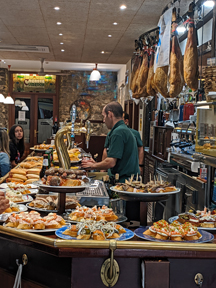
The first shock is that a great favorite in the new-style pintxos—nueva cocina en miniatura—Bar Zeruko, is closed for good. No one at a neighboring bar can (or will) say why. The next shock is that another favorite, Borda Berri is closed when we walk up, but we manage to translate a small printed sign “volvemos 5/9” to mean we’ll return September 5th....and that’s tomorrow. So we move on to one of the greats in the old style pintxos bars:
Ganbera
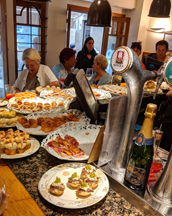 Ganbara, Ganbara....cara Ganbara.....one of our top favorites of the traditional style bars. A marvelous spread around the 90-degree bar of highest quality pintxos: mini croissants with Iberico or smoked salmon; half eggs mayonnaise with a shrimp perched atop; filled artichoke bottoms; spider crab tart. And at the end of the bar, huge piles of porcini, chanterelle, black trumpet, and hedgehog mushrooms; a mound of goose-neck barnacles; bowls of padron peppers; a tray of huge red carabineros deep-water shrimp.
Ganbara, Ganbara....cara Ganbara.....one of our top favorites of the traditional style bars. A marvelous spread around the 90-degree bar of highest quality pintxos: mini croissants with Iberico or smoked salmon; half eggs mayonnaise with a shrimp perched atop; filled artichoke bottoms; spider crab tart. And at the end of the bar, huge piles of porcini, chanterelle, black trumpet, and hedgehog mushrooms; a mound of goose-neck barnacles; bowls of padron peppers; a tray of huge red carabineros deep-water shrimp.
The blackboard offers hongos ala plancha; setas revueltos; langoustines ala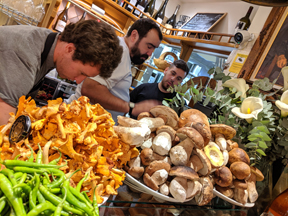 plancha; tempura white asparagus; txipirones en su tinto—tiny
plancha; tempura white asparagus; txipirones en su tinto—tiny 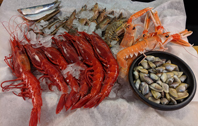 calamari in ink; berberechos—tiny clams....what a feast. We order white Rueda, Manzanilla sherry, and pick a few pintxos from the bar. Then a plate of mixed mushrooms with an egg yolk in the middle, and one of those enormous r
calamari in ink; berberechos—tiny clams....what a feast. We order white Rueda, Manzanilla sherry, and pick a few pintxos from the bar. Then a plate of mixed mushrooms with an egg yolk in the middle, and one of those enormous r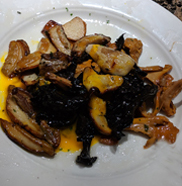 ed carabineros—almost a mini lobster. The setas are incredibly rich and earthy, the cardinal-red deep-water prawn the essence of the sea. Troy gets the honor of the best part....sucking the shrimp head.
ed carabineros—almost a mini lobster. The setas are incredibly rich and earthy, the cardinal-red deep-water prawn the essence of the sea. Troy gets the honor of the best part....sucking the shrimp head.
Cuchara di San Telmo
A re-visit is a must. Miraculously we find actual space at the bar, and strike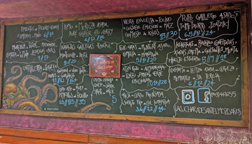 up a conversation with barman Anthony, whose pure Mayan-like visage leaves us unsurprised when we learn he was born Ecuadorian. We order Txacoli, the local slightly spritzy white, and Rueda to drink, and ponder the chalkboard menu. It has changed somewhat, but many of the iconic dishes survive.
up a conversation with barman Anthony, whose pure Mayan-like visage leaves us unsurprised when we learn he was born Ecuadorian. We order Txacoli, the local slightly spritzy white, and Rueda to drink, and ponder the chalkboard menu. It has changed somewhat, but many of the iconic dishes survive.
 Pimientos piquillo asados....fresh peppers, fire roasted and hand peeled served drizzled with good olive oil. We are reasonably happy at home with the piquillos in can or jar one can get there, but these are sublime.....sweet and richly peppery—spoiled! Morcilla de Pascal Massonde (a well-known Basque butcher) is very rich and delicious blood
Pimientos piquillo asados....fresh peppers, fire roasted and hand peeled served drizzled with good olive oil. We are reasonably happy at home with the piquillos in can or jar one can get there, but these are sublime.....sweet and richly peppery—spoiled! Morcilla de Pascal Massonde (a well-known Basque butcher) is very rich and delicious blood 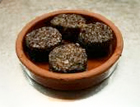 sausage, but even a small order is huge, and too much to finish.
sausage, but even a small order is huge, and too much to finish.
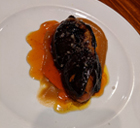 Carrillerra de ternera al vino tinto, with an herbed oil on garbanzo purée is as fine a sublime falling apart beef-cheek as memory serves. Foie now comes in three sizes instead of just pintxo. Foie Gras de Montfort asado con compote de manzana is dusted with sea salt and has a side drizzle of honey. We share a medio—in hindsight, two pintxo size would yield more crusted exterior.
Carrillerra de ternera al vino tinto, with an herbed oil on garbanzo purée is as fine a sublime falling apart beef-cheek as memory serves. Foie now comes in three sizes instead of just pintxo. Foie Gras de Montfort asado con compote de manzana is dusted with sea salt and has a side drizzle of honey. We share a medio—in hindsight, two pintxo size would yield more crusted exterior.
Vieira envuleta de tocino Guijuelo emulsion de maize—brings sea scallops wrapped in bacon of Guijuelo iberico with corn emulsion. To finish, the crema Catalana de queso de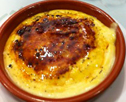 cabra, a goat-cheese flan topped with maple sirop is perfect...I’m thinking if they infused the syrup with rosemary.......Anthony asks if we’ve had the famous cheesecake at nearby La Viña, and we say not yet and not after this, but it’s on the list. “The best—soooo delicious” he intones.
cabra, a goat-cheese flan topped with maple sirop is perfect...I’m thinking if they infused the syrup with rosemary.......Anthony asks if we’ve had the famous cheesecake at nearby La Viña, and we say not yet and not after this, but it’s on the list. “The best—soooo delicious” he intones.
I ask Anthony what happened to the giant wooden spoon that used to hang on the wall by the entrance sort of as a sign, and he said “the idiot city council made us take it down!”
Borda Berri
Another must revisit. We are not so lucky with space here, and are crowded on all sides and behind. We manage to get glasses of Txacoli after a bit, and then order some pintxos.
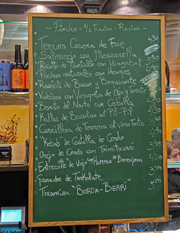 Terrine casera de foie is a nice change from grilled....homemade terrine
Terrine casera de foie is a nice change from grilled....homemade terrine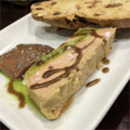 showered with sea salt and served with fruit marbalade and thin herbed-bread toasts.
showered with sea salt and served with fruit marbalade and thin herbed-bread toasts.
Bonito del Norte is a barely grilled, raw interior chunk of perfect tuna served with caramelized onions and a green drizzle of herb oil.
“Kebab” de costilla de Cerdo is a long cooked chunk of pork rib—falling apart meat with almost no bone.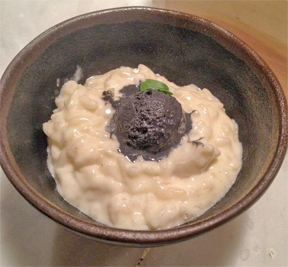
Risotto de “puntapete” con Idiazabal is actually creamy orzo. Puntapete translates to “kick” and we’re unsure what it means, but perhaps refers to the kick of the pungent Spanish blue cheese. In any event, it’s deli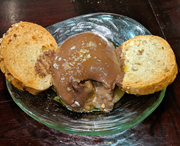 cious.
cious.
For a sweet bite there is ganache de txokolate which brings a large quenelle of intense thick chocolate mousse with a couple of sugar cookies to scoop with.
Bar Haizea
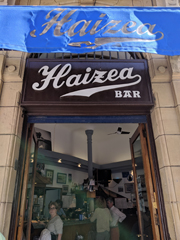 Haizea is a traditional bar that most tourists seem to miss, which ventures in a few areas toward the cocina nueva. As we arrive, locals spill into
Haizea is a traditional bar that most tourists seem to miss, which ventures in a few areas toward the cocina nueva. As we arrive, locals spill into 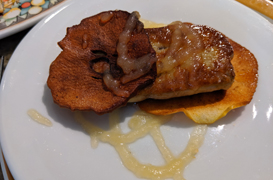 the street, and there isn’t a single other tourist in the bar. Haizea has a revered foie gras pintxo served with caramelized apple slices and a drizzle of what might be herbed honey.
the street, and there isn’t a single other tourist in the bar. Haizea has a revered foie gras pintxo served with caramelized apple slices and a drizzle of what might be herbed honey.
Brik de bacalao is the cutest square packet of brik—a phyllo like dough—surrounding creamy cod and potato puree, and tied with a string of scallion.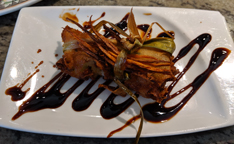
Bunuelos de bacalao y gambas are crispy seafood donuts, basically, and the Bonito ala plancha enceballado is the freshest tuna grilled and covered in melting onions.
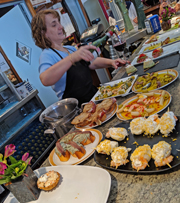 I order the bocadillo de lengua con pimiento, thinking it’s one of the tiny rolls filled with tender tongue but it proves to be an enormous sandwich of tongue slices and red peppers.
I order the bocadillo de lengua con pimiento, thinking it’s one of the tiny rolls filled with tender tongue but it proves to be an enormous sandwich of tongue slices and red peppers.
Haizea is a really fun and lively place, and we’ll stop in multiple additional times, just for the foie and the brik.
La Viña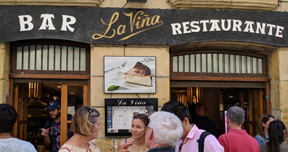
Finally, we stroll to La Viña in Kalea 31 de Agosto for the famous cheesecake. The street is overflowing, and the bar is chock-a-block....mostly with locals, by the voices. The cheesecake is almost burnt at the edges, and is smooth, unctuous and utterly delicious. 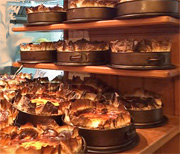 Somewhere between creme caramel and New York cheesecake, the delicacy is made with just cream cheese, eggs, sugar, flour and salt. The walls at La Viña are lined with stack upon stack of cheesecakes, still in their springform pans. They come down gradually as the day goes on and de
Somewhere between creme caramel and New York cheesecake, the delicacy is made with just cream cheese, eggs, sugar, flour and salt. The walls at La Viña are lined with stack upon stack of cheesecakes, still in their springform pans. They come down gradually as the day goes on and de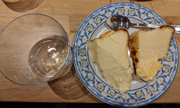 mand continues. This may be the most famous cheesecake in all of Europe. It’s intense, rich and sweet, and a glass of iced Orujo—Spanish grappa—is the perfect accompaniment to cut the sweetness, and complete a fantastic Donostia visit.
mand continues. This may be the most famous cheesecake in all of Europe. It’s intense, rich and sweet, and a glass of iced Orujo—Spanish grappa—is the perfect accompaniment to cut the sweetness, and complete a fantastic Donostia visit.
La Viña Cheesecake
1 1/2 cups sugar
2 1/4 pounds cream cheese, at room temperature
5 large eggs
2 cups heavy cream
¼ cup flour
¼ teaspoon sea salt
Method: Preheat oven to 400 F. Butter a 10-inch springform pan and line it with parchment paper, with 2 to 3 inches overhanging the top of the pan on all sides. Pleating the paper in a few places.
In a good-sized bowl, cream the sugar, salt and cream cheese with a mixer, or by hand until smooth. Mix in the the eggs one by one and stir until fully blended. Whisk in the cream. With a sifter, add the flour to the mixture and fold it in gently.
Pour the mixture into the parchment-lined pan and bake for 50 minutes, or until well browned and almost burnt-looking on top. This can vary by oven, so keep watch on the cheesecake from about 45 minutes on. The center will be fairly jiggly, but will firm with cooling. Remove from the oven and cool on a wire rack.
Before serving, remove the outer part of the springform and gently tug away the parchment paper. Cut into slices and serve with a chilled glass of Orujo, or other grappa
Recipe adapted from "Basque Country" by Marti Buckley
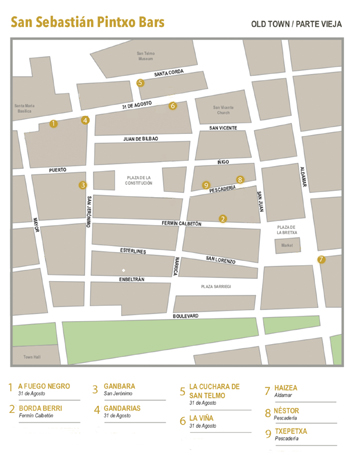
 Hightower | Comments Off |
Hightower | Comments Off |